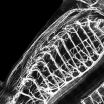(Press-News.org) A new study identifies molecules that can be used to selectively reduce generation of the sticky, neuron-damaging plaques that are the hallmark of the Alzheimer's disease (AD) brain. The research, published by Cell Press in the September 9 issue of the journal Neuron, may lead to the development of effective and safe therapeutics for this currently incurable disease.
Previous research has suggested that an alteration in brain levels of amyloid ? proteins (A?) plays a major pathogenic role in AD, a devastating neurodegenerative disorder that causes progressive cognitive impairment and memory loss. AD is characterized by abnormal levels of A? that accumulate in the brain and form plaques that are toxic to neurons.
"A? peptides are generated when enzymes called gamma secretases snip a large protein called amyloid precursor protein (APP) into smaller pieces," explains senior study author, Dr. Steven L. Wagner from the University of California, San Diego. "Early approaches to therapeutic intervention focused on lowering total A? peptide production by using gamma secretase inhibitors (GSIs). However, this often led to adverse effects because gamma secretases are required for other key cellular activities."
Dr. Wagner and colleagues developed a screen to identify compounds (called gamma secretase modulators) that would preferentially reduce levels of the harmful A? protein without interfering with the other necessary gamma secretase functions. They identified and characterized a class of aminothiazole gamma secretase modulators (AGSMs) that selectively reduced generation of harmful A??proteins and displayed unique pharmacological properties when compared with the GSIs that are currently being used in AD clinical trials.
Dr. Wagner's group then tested the most potent orally available AGSM compound in a mouse model of AD and found that the drug significantly lowered the amount of pathological A? proteins, reduced plaque density in the brains of the treated mice and did not exhibit the toxicity associated with standard GSI treatment.
The compounds discovered in this study are unique in that they do not just globally inhibit gamma secretases but instead interact with the enzymes to selectively modulate activity, sparing the necessary enzyme functions.
"Gamma secretase is an excellent target for Alzheimer's drug discovery; however, it is also a vital enzyme with many different roles in the body. Thus, you cannot hit with a sledgehammer, but must, instead, gently tweak its activity to regulate its effects on amyloid beta protein while allowing it to carry out its many other functions," adds study coauthor, Dr. Rudolph E. Tanzi, from Massachusetts General Hospital. "The gamma secretase modulators we describe in this study do just that and thus represent a potentially valuable class of drug for the treatment and prevention of Alzheimer's disease".
The researchers are optimistic about how AGSMs might improve treatment strategies for AD. "Hopefully these types of molecules will ultimately be shown to be safe and effective in further preclinical studies and in humans," concludes Dr. Wagner. "If that turns out to be the case, they may someday in the future be used for inhibiting or even preventing AD in a manner similar to how cholesterol lowering drugs are used to treat cardiovascular diseases today."
###
The researchers include Maria Z. Kounnas, TorreyPines Therapeutics, Inc., La Jolla, CA; Anne M. Danks, TorreyPines Therapeutics, Inc., La Jolla, CA; Soan Cheng, TorreyPines Therapeutics, Inc., La Jolla, CA; Curtis Tyree, TorreyPines Therapeutics, Inc., La Jolla, CA; Elizabeth Ackerman, TorreyPines Therapeutics, Inc., La Jolla, CA; Xulun Zhang, University of Chicago, Chicago, IL; Kwangwook Ahn, Memorial Sloan Kettering Cancer Center, New York, NY; Phuong Nguyen, TorreyPines Therapeutics, Inc., La Jolla, CA; Dan Comer, TorreyPines Therapeutics, Inc., La Jolla, CA; Long Mao, TorreyPines Therapeutics, Inc., La Jolla, CA; Chengzhi Yu, TorreyPines Therapeutics, Inc., La Jolla, CA; David Pleynet, TorreyPines Therapeutics, Inc., La Jolla, CA; Paul J. Digregorio, TorreyPines Therapeutics, Inc., La Jolla, CA; Gonul Velicelebi, TorreyPines Therapeutics, Inc., La Jolla, CA; Kenneth A. Stauderman, TorreyPines Therapeutics, Inc., La Jolla, CA; William T. Comer, TorreyPines Therapeutics, Inc., La Jolla, CA; William C. Mobley, University of California, San Diego, La Jolla, CA; Yue-Ming Li, Memorial Sloan Kettering Cancer Center, New York, NY; Sangram S. Sisodia, University of Chicago, Chicago, IL; Rudolph E. Tanzi, Massachusetts General Hospital, Department of Neurology, Charlestown, MA; and Steven L. Wagner, TorreyPines Therapeutics, Inc., La Jolla, CA.
END
Addictive drugs are known to induce changes in the brain's reward circuits that may underlie drug craving and relapse after long periods of abstinence. Now, new research, published by Cell Press in the September 9 issue of the journal Neuron, uncovers a specific neural mechanism that may be linked to persistent drug-seeking behavior and could help to guide strategies for development of new therapies for cocaine addiction.
Previous research has shown that the ventral tegmental area (VTA) is a brain region that is activated when cocaine users experience a craving for cocaine ...
New York (September 8, 2010) – In a surprising and unexpected discovery, scientists at NYU Langone Medical Center have found that a single type of gene acts as a master organizer of motor neurons in the spinal cord. The finding, published in the September 9, 2010 issue of Neuron, could help scientists develop new treatments for diseases such as Lou Gehrig's disease or spinal cord injury.
The "master organizer" is a member of the Hox family of genes, best known for controlling the overall pattern of body development. By orchestrating a cascade of gene expression in ...
A team of scientists, led by University of California, San Diego School of Medicine researchers, has synthesized hundreds of new compounds with the potential of reducing the production of the A-beta 42 peptide, a primary component of Alzheimer's disease (AD).
In mouse models, one tested compound specifically reduced levels of A-beta 42, which is believed to be responsible for the destruction of neurons, but left other essential enzymatic activities in the brain unaffected, said Steven Wagner, PhD, a project scientist in the UCSD Department of Neurosciences.
The ...
A group of international astronomers in the UK, France and the USA, led by the University of Leicester, have found proof to confirm the distance and brightness of the most extreme ultra-luminous X-ray source, which may herald a new type of Black Hole.
The X-ray source, HLX-1, is the most extreme member of an extraordinary class of objects – the ultra-luminous X-ray sources – and is located in the galaxy ESO 243-49 at a distance of ~300 million light years from the Earth.
The astronomers' findings confirm that the extreme luminosity (which is a factor of ~100 above ...
CAMBRIDGE, Mass. – A type of neuron that, when malfunctioning, has been tied to epilepsy, autism and schizophrenia is much more complex than previously thought, researchers at MIT's Picower Institute for Learning and Memory report in the Sept. 9 issue of Neuron.
The majority of brain cells are called excitatory because they ramp up the action of target cells. In contrast, inhibitory cells called interneurons put the brakes on unbridled activity to maintain order and control. Epileptic seizures, as well as symptoms of autism and schizophrenia, have been tied to dysfunctional ...
SAN DIEGO -- In the Sept 9, 2010 issue of Neuron, Neurogenetic Pharmaceuticals, Inc. (NGP) reports proof of concept studies that show its proprietary compound, NGP 555, is effective in preventing the amyloid pathology of Alzheimer's disease (AD) in a transgenic mouse model. The study further demonstrates that following chronic treatment with the gamma secretase modulator (GSM) compound from NGP, the mice were devoid of gastrointestinal side effects, an adverse finding commonly associated with gamma secretase inhibitors (GSIs).
A major pathological hallmark of Alzheimer's ...
Scientific research published in the current issue of the Journal of the American Medical Informatics Association (JAMIA) reports on a study of genetic variants that influence human susceptibility to peripheral arterial disease (PAD), made possible by leveraging electronic medical records (EMRs; also called EHRs or electronic health records). A team of authors from the Mayo Clinic Divisions of Cardiovascular Diseases and Biomedical Informatics and Statistics conducted the study and concluded that EMR-based data, used across institutions in a structured way, "offer great ...
NOAA's Fisheries Service has designated the eastern North Pacific basking shark, a "species of concern" because it has suffered a dramatic decline in population despite decreasing fishing pressure. The label "species of concern" may be given to a species when there are concerns regarding the population status.
The eastern Pacific basking shark is not being considered for listing pursuant to the Endangered Species Act, rather it is a species of concern because it has been over fished and its population has apparently not responded to conservation measures implemented ...
An international study has discovered the reason why some people who eat a high-fat diet remain slim, yet others pile on the weight.
The study, led in Australia by the Monash Obesity and Diabetes Institute (MODI) at Monash University, found a high-fat diet causes brain cells to become insulated from the body preventing vital signals, which tell the body to stop eating and to burn energy, from reaching the brain efficiently.
MODI director and Australian Life Scientist of the Year Professor Michael Cowley said there were two clear outcomes from the findings.
'We discovered ...
LOS ANGELES – Sept. 7, 2010 – Researchers in Cedars-Sinai's Department of Psychiatry and Behavioral Neurosciences have reported people who undergo massage experience measureable changes in their body's immune and endocrine response.
Although there have been previous, smaller studies about the health benefits of massage, the Cedars-Sinai study is widely believed to be the first systematic study of a larger group of healthy adults.
The study is published online at http://www.liebertonline.com/loi/acm. It also will be published in the October printed edition of ...


